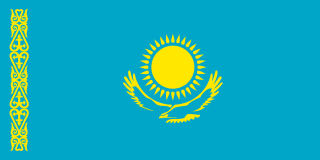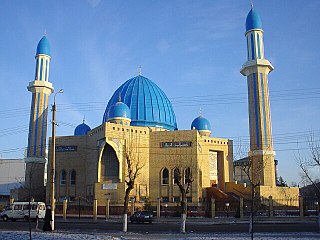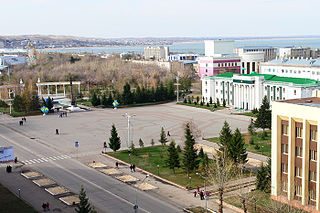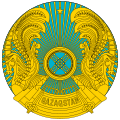
Kazakhstan, officially the Republic of Kazakhstan, is a landlocked country mostly in Central Asia, with a part in Eastern Europe. It borders Russia to the north and west, China to the east, Kyrgyzstan to the southeast, Uzbekistan to the south, and Turkmenistan to the southwest, with a coastline along the Caspian Sea. Its capital is Astana, while the largest city and leading cultural and commercial hub is Almaty. Kazakhstan is the world's ninth-largest country by land area and the largest landlocked country. It has a population of 20 million and one of the lowest population densities in the world, at fewer than 6 people per square kilometre. Ethnic Kazakhs constitute a majority, while ethnic Russians form a significant minority. Officially secular, Kazakhstan is a Muslim-majority country, although ethnic Russians in the country form a sizeable Christian community.

Kazakhstan, the largest country fully within the Eurasian Steppe, has been a historical crossroads and home to numerous different peoples, states and empires throughout history. Throughout history, peoples on the territory of modern Kazakhstan had nomadic lifestyle, which developed and influenced Kazakh culture.

Petropavl ; Russian: Петропавловск, romanized: Petropavlovsk) is a city on the Ishim River in northern Kazakhstan close to the border with Russia. It is the capital of the North Kazakhstan Region. Population: 218,956. The city is also known colloquially in Kazakh as Qyzyljar.

The Kazakh Soviet Socialist Republic, also known as Soviet Kazakhstan, the Kazakh SSR, or simply Kazakhstan, was one of the transcontinental constituent republics of the Soviet Union (USSR) from 1936 to 1991. Located in northern Central Asia, it was created on 5 December 1936 from the Kazakh ASSR, an autonomous republic of the Russian SFSR.

The Kazakhs are a Turkic ethnic group native to Central Asia and Eastern Europe, mainly Kazakhstan, but also parts of northern Uzbekistan and the border regions of Russia, as well as northwestern China and western Mongolia. The Kazakhs arose from the merging of the medieval tribes of Turkic and Mongolic origin in the 15th century.

Kokshetau, formerly known as Kokchetav is a lakeside city in northern Kazakhstan and the capital of Akmola Region (oblys), which stretches along the southern shore of Lake Kopa, lying in the north of Kokshetau Hills, a northern subsystem of the Kokshetau Uplands (Saryarka) and the southern edge of the Ishim Plain. It is named after the Mount Kokshe.

Islam is a major religious minority in the Russian Federation, which has the largest Muslim population in Europe. According to the US Department of State in 2017, Muslims in Russia numbered 14 million or roughly 10% of the total population. One of the Grand Muftis of Russia, sheikh Rawil Gaynetdin, estimated the Muslim population of Russia at 25 million in 2018.

Russian Turkestan was the western part of Turkestan within the Russian Empire’s Central Asian territories, and was administered as a Krai or Governor-Generalship. It comprised the oasis region to the south of the Kazakh Steppe, but not the protectorates of the Emirate of Bukhara and the Khanate of Khiva. It was populated by speakers of Russian, Uzbek, Kazakh, Kyrgyz, and Tajik.

The Turkestan–Siberian Railway is a 1,520 mm broad gauge railway that connects Central Asia with Siberia. It starts north of Tashkent in Uzbekistan at Arys, where it branches off from the Trans-Aral Railway. It heads roughly northeast through Shymkent, Taraz, Bishkek to the former Kazakh capital of Almaty. There it turns northward to Semey before crossing the Russian border. It passes through Barnaul before ending at Novosibirsk, where it meets the West Siberian portion of the Trans-Siberian Railway. The bulk of construction work was undertaken between 1926 and 1931.

North Kazakhstan Region is a region of Kazakhstan, with a population of 539,111. Its capital is Petropavl, with a population of 193,300 people.

The Alash Autonomy, also known as Alash Orda was an unrecognized Kazakh provisional government, or proto-state, located in Central Asia and was part of the Russian Republic, and then Soviet Russia. The Alash Autonomy was founded in 1917 by Kazakh elites, and disestablished after the Bolsheviks banned the ruling Alash party. The goal of the party was to obtain autonomy within Russia, and to form a national, democratic state. The political entity bordered Russian territories to the north and west, the Turkestan Autonomy to the south, and China to the east.

Kazakhstan–Russia relations are the bilateral foreign relations between Kazakhstan and the Russian Federation. Kazakhstan has an embassy in Moscow, a consulate-general in Saint Petersburg, Astrakhan and Omsk. Russia has an embassy in Astana and consulates in Almaty and Oral.
Ukrainian Kazakhstanis are an ethnic minority in Kazakhstan that according to the 1989 census numbered 896,000 people, or 5.4% of the population. Due to subsequent emigration to Russia and Ukraine, this number had declined to 796,000 by 1998 and 456,997 in the 2009 census.

Kazakhstan is a multiethnic country where the indigenous ethnic group, the Kazakhs, comprise the majority of the population. As of 2023, ethnic Kazakhs are about 71% of the population and ethnic Russians in Kazakhstan are about 15%. These are the two dominant ethnic groups in the country with a wide array of other groups represented, including Ukrainians, Uzbeks, Germans, Tatars, Chechens, Ingush, Uyghurs, Koreans, and Meskhetian Turks.

The Kazakhstan–Russia border is the 7,644-kilometre (4,750 mi) international border between the Republic of Kazakhstan and the Russian Federation. It is the longest continuous international border in the world and the second longest by total length, after the Canada–United States border. It is in the same location as the former administrative-territorial border between the Kazakh Soviet Socialist Republic and the Russian Soviet Federative Socialist Republic.
The Eastern Orthodox Church in Kazakhstan is a metropolitan district or metropolia of the Russian Orthodox Church. Although not autonomous or fully self-governing like the Ukrainian Orthodox Church under the Moscow Patriarchate, the Church in Kazakhstan has been given some self-government, with jurisdiction over all Orthodox Christians in Kazakhstan. Most of its members are ethnic Russians, Ukrainians, Koreans, and Belarusians resident in Kazakhstan.

The conquest of Central Asia by the Russian Empire took place in the second half of the nineteenth century. The land that became Russian Turkestan and later Soviet Central Asia is now divided between Kazakhstan in the north, Uzbekistan across the center, Kyrgyzstan in the east, Tajikistan in the southeast, and Turkmenistan in the southwest. The area was called Turkestan because most of its inhabitants spoke Turkic languages with the exception of Tajikistan, which speaks an Iranian language.
The Starving March was the retreat of the Orenburg Independent Army under command of generals Alexander Dutov and Andrei Bakic in the winter of 1919–1920 from the area around Kokchetav over Sergiopol, through Kazakhstan towards Semirechye on the Kazakh-Chinese border.

Kenesary's Rebellion was the longest and uprising of the Kazakh people on the territory of modern Kazakhstan under the leadership of Khan Kenesary Qasymov against the Russian Empire.
Kazakh–Russian ethnic conflicts refers to the ethnic clashes between Kazakhs and Russians that occurred from the late 20th to early 21st century. These clashes were accompanied by riots and disorder.



















